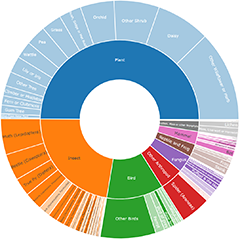Fungi associated with Eucalypts species
Posted by Steve818
Overview
This is a collection of sightings of fungi that are often associated with Eucalypts. There are three categories: Parasites, Mycorrhizas, and Saprotrophs.
Major parasites cause dieback. Mycorrhizas support growth and plant health. Saprotrophs are decomposers of heartwood and leaf litter, and they help form tree hollows for wildlife. The saprotrophs recycle nutrients and this contributes to plant health.
In the examples below, the taxa with a # have sightings in the collection.
Some fungi do not have conspicuous sporophores, so direct sightings are unlikely. If a Eucalypt is unhealthy and you suspect it is due to a fungi or fungi-like parasite then add a sighting to the related collection project, 'Eucalypt health surveillance' https://canberra.naturemapr.org/collections/sightings/10933
Parasites
Parasites include fungi-like parasites, root rot fungi, canker fungi, and leaf fungi.
Examples of parasites:
- Fungi-like parasites: Phytophthora cinnamomi.
- Root rot fungi: Armillaria #
- Canker fungi: Botryosphaeria, Cytospora, Cryphonectria, Endothioa, and Endothiella
- Leaf fungi: Austropuccinia psidii (myrtle rust), Aulographina eucalypti, Mycosphaerella molleriana, M. cryptica, Phaeothyriolum microthyriooides, Discosia eucalypticola, Pseudosydowia eucalypti # and Ophiodothella longispora
Pseudosydowia eucalypti has been the cause of dieback of Eucalyptus globulus planted overseas. In Canberra and the Southern Tablelands it affects E.globulus subsp. bicostata.
Some leaf fungi that are parasites, allow access for saprotrophs. In this way Eucalypt leave decay can commence before leaf fall.
Mycorrhizas
Mycorrhizas include VAM, and ectomycorrhizas. Examples of mycorrhizas with conspicuous sporophores: Phaeohelotium (Discinella terrestris aggregate) #, Lactifluus wirrabara, Lactarius eucalypti #, Tricholoma eucalypticum #, Cortinarius archeri #, and C. austrovenetus #.
Saprotrophs
Saprotrophs include white rots and brown rots that decompose heartwood and logs. They also decompose litter (i.e twigs, bark, and leaves). Brown rots decompose cellulose and hemicellulose, leaving wood brown and crumbly. White rots decompose lignin as well, leaving wood spongy and pale.
Examples of saprotrophs: Inonotus #, Gymnopilus #, Chondrostereum, Hymenochaete #, Macrohyporia, Phellinus #, Omphalotus #, Piptoporus #, Laetiporus #, Fistulina #, Mycena #, Omphalotus nidiformis #, and Trametes coccinea #.
Bark-inhabitating lichenised fungi can also be found on some Eucalypts, e.g. Chrysothrix xanthina # on red stringybarks. Regular bark shedding means there are less species of lichenised fungi associated with Eucalypts compared to rainforest trees.
How to contribute
If you are unsure that your sighting is a species associated with Eucalypts, then check against the taxa listed above or consult the NatureMapr fungi moderator who identified your sighting.
Sightings can be added to this collection by clicking on the the star icon at the top right of the sighting page and then select 'Fungi associated with Eucalypts' from the collection list.
Add a sighting
No species currently belong to this list.

